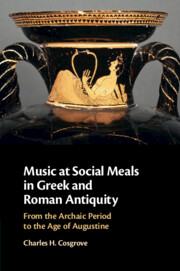This article revisits the question of how elegy was performed at the symposion, and argues that, rather than being either musical or non-musical, elegy situates itself between speech and song. None of the passages in which elegy mentions song are clearly self-referential: they tend to be generic, set in the future, concerned with other performers and other compositions or altogether too slippery in their language to pin them down. Moreover, there are a number of elegiac pieces that appear designed to allow symposiasts to shift from song to speech or speech to song, thereby introducing a new mode of performance, and so are themselves transitional. These observations about the way elegiac texts position their own performance are complemented by considerations about their actual performance. Evidence both from ancient musicologists and from other tonal languages suggests that inbetween modes of delivery were common in Greek poetry and the metrical shape makes elegy a prime candidate. The final section of the article turns to the difficult term elegos in fifth-century drama. It argues that several of these passages draw on inbetweenness as one association of elegos and thus decreases the gap between elegos and surviving elegy. A coda points out that the elegiacs in Euripides' Andromache are a further example of elegy transitioning between two modes of performance.
